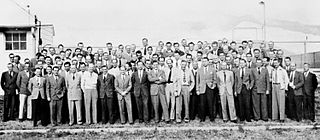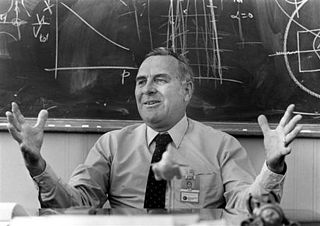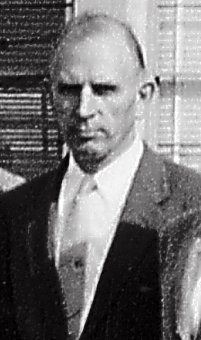
Operation Paperclip was a secret United States intelligence program in which more than 1,600 German scientists, engineers, and technicians were taken from the former Nazi Germany to the U.S. for government employment after the end of World War II in Europe, between 1945 and 1959. Conducted by the Joint Intelligence Objectives Agency (JIOA), it was largely carried out by special agents of the U.S. Army's Counterintelligence Corps (CIC). Many of these personnel were former members and some were former leaders of the Nazi Party.

Bernhard Robert Tessmann was a German expert in guided missiles during World War II, and later worked for the United States Army and NASA.

Ernst Stuhlinger was a German-American atomic, electrical, and rocket scientist. After being brought to the United States as part of Operation Paperclip, he developed guidance systems with Wernher von Braun's team for the US Army, and later was a scientist with NASA. He was also instrumental in the development of the ion engine for long-endurance space flight, and a wide variety of scientific experiments.

Eberhard Friedrich Michael Rees was a German-American rocketry pioneer and the second director of NASA's Marshall Space Flight Center.

Konrad Dannenberg was a German-American rocket pioneer and member of the German rocket team brought to the United States after World War II.

Ernst Geissler was a German-American aerospace engineer. After World War II, he went to the United States on 16 November 1945 as part of the Argentina group, Operation Paperclip.
Helmut Hoelzer was a Nazi Germany V-2 rocket engineer who was brought to the United States under Operation Paperclip. Hoelzer was the inventor and constructor of the world's first electronic analog computer.
Georg Heinrich Patrick Baron von Tiesenhausen was a Baltic-German-born American rocket scientist.

Werner Karl Dahm was an early spaceflight scientist of the Peenemünde Future Projects Office who emigrated to the US under Operation Paperclip and was the Marshall Space Flight Center Chief Aerodynamicist.

Walter Haeussermann was a German-American aerospace engineer and member of the "von Braun rocket group", both at Peenemünde and later at Marshall Space Flight Center, where he was the director of the guidance and control laboratory. He was awarded the Department of the Army Decoration for Exceptional Civilian Service in 1959 for his contributions to the US rocket program.

Walter Jacobi was a rocket scientist and member of the "von Braun rocket group", at Peenemünde (1939–1945) working on the V-2 rockets in World War II.

Dieter Grau was a German-born American aerospace engineer and member of the "von Braun rocket group", at Peenemünde (1939–1945) working on the V-2 rockets in World War II. He was among the engineers who surrendered to the United States and traveled there, providing rocketry expertise via Operation Paperclip, which took them first to Fort Bliss, Texas. Grau was sent by the U.S. Army to White Sands in 1946 to work on the assemblage and testing of the V-2. His wife joined him there in 1947. While von Braun was on standby at Fort Bliss, Grau and other German aerospace engineers busily launched V-2s for U.S. scientists to analyze. A total of 67 V-2s were launched at White Sands.

Hans Hermann Hüter was a German-Swiss rocket engineer.

William "Willi" Mrazek was a German-American loads engineer and member of the "von Braun rocket group." Mrazek worked first at Peenemünde Army Research Center and later, through Operation Paperclip, at Fort Bliss and the Marshall Space Flight Center, where he was involved with the development of the Saturn V rocket.
Heinz Hilten was a German-American architect and member of the "von Braun rocket team." He was a later Operation Paperclip hire and was involved in the design of numerous buildings in Space Age-era Huntsville, Alabama, both for NASA and for general use.
Karl Ludwig Heimburg was a German-American engineer and Operation Paperclip hire. Heimburg was a member of the "von Braun rocket team" and served as the initial director of the Test Division at the Marshall Space Flight Center.
Gerhard Herbert Richard Reisig was a German-American engineer and rocket scientist. He worked at the Peenemünde Army Research Center during World War II and later, through Operation Paperclip, at the Marshall Space Flight Center.
Helmut Justus Karl Horn was a German-American engineer and applied physicist who was employed at the early Marshall Space Flight Center. Horn worked first at the Peenemünde Army Research Center and later, after the end of World War II, was hired by the U.S. through Operation Paperclip.
Gerhard B. Heller was a German-American rocket scientist and member of the "von Braun rocket team." He worked at Peenemünde Army Research Center during World War II and later, through Operation Paperclip, moved to develop rockets for the U.S., eventually becoming employed at the Marshall Space Flight Center.

Heinrich Georg "Heinz" Struck was a German-American rocket scientist and member of the "von Braun rocket team." Struck worked in aerodynamics in both the private and federal sectors, particularly NASA, where he was recognized for his contributions to the Space Shuttle program.













